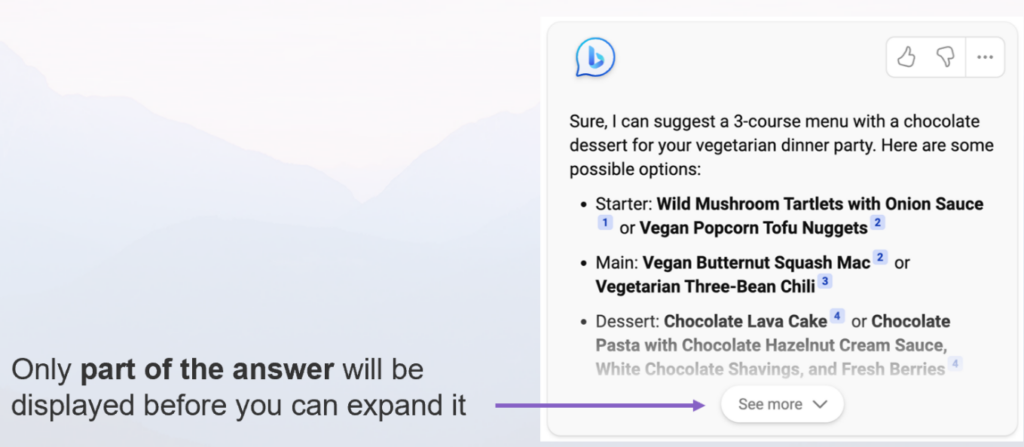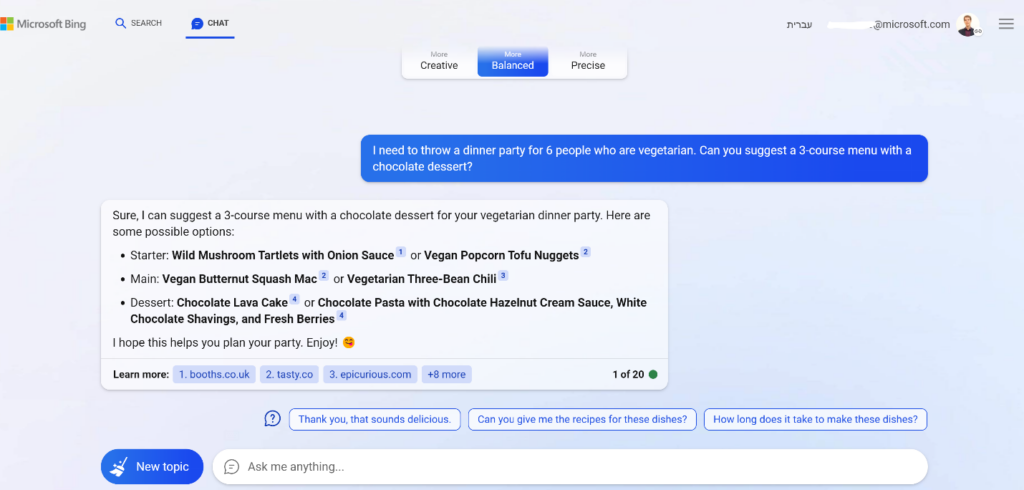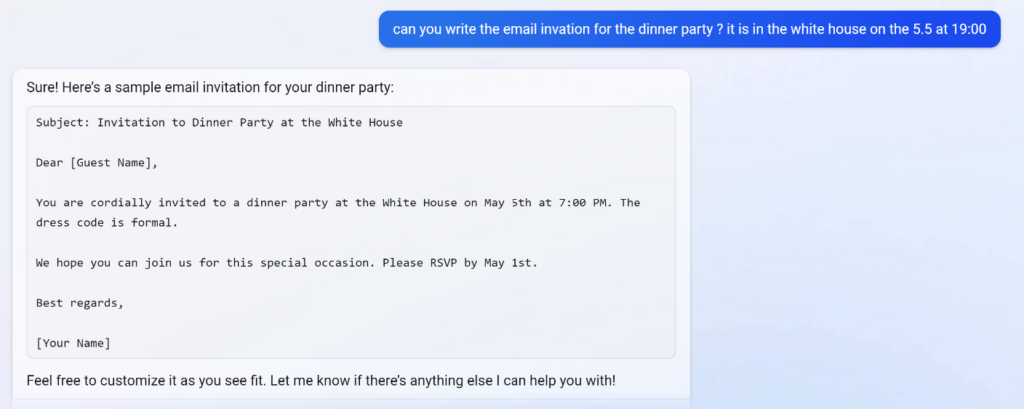This is Part 3 of our series on generative AI and Azure OpenAI Service. Click here to read Part 1 which focused on the basics, and click here for Part 2, a deep-dive into Microsoft Copilot.
User experience (UX) is a crucial factor for any product or service, especially for startups trying to draw in more customers, prove their product in the marketplace, and build their brand reputation. Generative AI UX uses AI algorithms and models to automatically generate or assist in the creation of user interfaces, designs, and interactive experiences, with a goal to streamline and enhance the design process.
In our previous post, we introduced you to Microsoft Copilot, a tool powered by OpenAI’s GPT-4 that appears as a chatbot in the sidebar of Microsoft’s existing apps. For a startup looking to improve UX while also freeing up financial and personnel resources to focus on strategy and innovation, adapting Copilot is an easy, cost-effective way to stay competitive.
The new Bing: A UX deep dive
In this blog, we will share some insights from our journey creating the new Bing search experience. Launched in February, these new experiences are powered by a combination of Azure OpenAI’s most advanced GPT models and Bing’s own proprietary technology called Prometheus, which leverages the fresh and comprehensive Bing index, ranking, and answers results. (More about Prometheus in Part 4 of this series.) The result is a more accurate, complete, and engaging search experience that can answer long, complex, and natural queries.
Expanded search parameters
- A better search experience provides more relevant results for basic inquiries. Additionally, it features a new sidebar that presents more detailed responses for those who seek them. The search box, which now prompts you to “ask me anything,” now allows a word count of up to 1000 words.
- Copilot chat enhances the user experience of complex systems in startups by providing real-time support and guidance to the users. It allows users to access hidden features and customize their settings with natural language commands. A Copilot chat option can also provide helpful tips and feedback to improve the user’s performance and satisfaction. By adding a Copilot chat option, startups can make their systems more value to their users and increase retention.

Adding extra content to answers
- In addition to providing results from across the web and summarizing the answers, the new Bing works to reduce the visual load. Instead of revealing all the information at the beginning, it gives the user a glimpse of what you have to offer and invites them to explore further. This creates a more engaging and interactive experience, which can help startups attract new business and keep repeat clients.

- The new Bing takes a proactive approach to answering inquiries, generating related questions that will help to continue exploration.

- By choosing “Let’s chat,” the user will be redirected to Copilot mode called Bing Chat Mode, where they can conduct further investigation into the answers.

Chat Mode
- By chatting naturally and asking follow-up questions to your initial search, users can get more specific, clear, or creative results by typing or speaking like you would to a friend. For startups, this kind of instant communication with clients can be the difference between growing a customer base and struggling to find market traction.
- With a reduced visual load, Chat mode lets you enjoy a distraction-free experience as you explore the results. When you choose this option, a new window will open for you and the search bar now allows up to 2000 words.
- The proactive approach continues as the chats create relevant follow up questions at every turn. (A “turn” is a conversation exchange which contains both a user question and a reply from Bing.)

Improving trust and avoiding hallucination

- Search hallucination refers to a phenomenon that can occur in the context of search engines, particularly when using natural language queries. It refers to situations where a search engine returns results that are not directly relevant or accurate. With the new Bing experience, references are numbered to help the user understand the source of the answer, helping reduce hallucination.

- Reinforcement learning is a type of machine learning that learns from its own actions and rewards. In Bing chat, we use reinforcement learning to improve our responses based on the feedback from users. For example, if a user likes our response, we get a positive reward and we try to generate more responses like that. If a user dislikes our response, we get a negative reward and we try to avoid generating responses like that. By using reinforcement learning, we hope to make Bing chat more engaging, helpful, and satisfying for users.
Create
- When you choose the Creative mode, you can expect to receive responses that are original and surprising. It can generate content to help you with tasks such as writing an email, creating a travel itinerary, preparing for a job interview, or making a quiz. This has no end of uses for startups looking to differentiate themselves in their field or stand out from competitors.

- This mode can start with something simple that feel safe. The user then reviews it and makes any necessary changes.

- Azure Open AI Service can reformat the text structure or language of any input, such as making it more concise, clear, or creative. For example, a user can recreate the email in French:

- The user can then recreate the email as a table and translate back to English.

- Or even make into JSON format:

- Using Generative AI image technologies such as DALL-E 2 in Azure OpenAI Service combined with Open AI GPT-4, users can chat about the image creation and adjust it using prompts and suggested prompts.

Sharing chat responses
Although the chatbot already included an option to share an answer, the updated interface now enables users to share a “persistent” link and screenshot on various widely-used social media platforms such as Facebook, Twitter, and Pinterest, as well as through email.
Turn Counters
We’ve set a limit on how many turns you can take in one chat session. Long chats can sometimes confuse chat models and make it harder for them to give users the best answers.
We’ve found that most people get the answers they need in just 5 turns, and only about 1% of chats go over 50 messages.
- Indicate the status to the user by color coding
- Green 1-10

- Orange 11-19

- Red once you hit 20 turns, we’ll prompt you to start a new topic.

- When you’re done chatting, just click the broom icon to clear things out and start fresh.
Key takeaways for startups
- Generative AI UX can improve your product or service by delivering precise, pertinent, and customized outcomes to your users. Crafting a well-structured Generative AI UX will aid you create new features and functionalities that differentiate your product or service from others.
- Ground your prompt with data. For AI models to effectively learn and reason, they require data. Incorporating data into your AI can enhance its precision and dependability. Moreover, data can facilitate the inclusion of references and sources to support your AI’s outputs, instilling user confidence and enabling verification of information.
- Make your UX design to be user-friendly and engaging. The UX must be effortless for users to utilize and comprehend. Additionally, the UX must be flexible and accommodating to cater to the specific requirements and preferences of users. Creating an immersive UX experience is also critical to encouraging users to utilize your product or service enthusiastically.
- Conduct continuous testing and iteration. UX is an ongoing process, and it necessitates constant evaluation and enhancement based on user feedback and data analysis. Furthermore, UX must be modified and polished in response to evolving user behaviors and expectations.
In Part 4 of our series, we will learn about the new Plugins system and Bing’s new architecture.
Microsoft for Startups Founders Hub members receive Azure cloud credits that can be used toward Azure OpenAI Service or OpenAI to help build their product. Sign up now to become a member.







